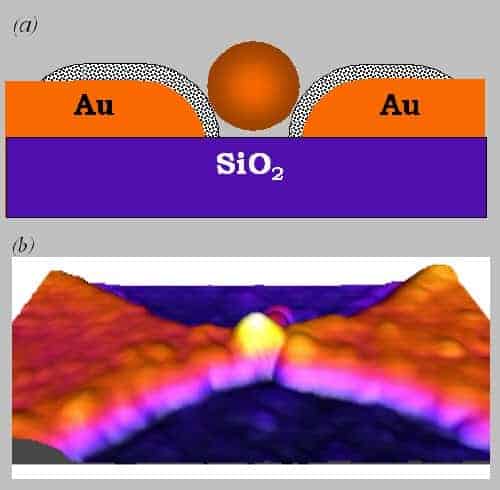
A tiny mechanical shuttle that can move just four electrons at a time has been built by physicists in the UK. The device could lead to the development of a new generation of nanoelectromechanical devices (NEMS) — including logic devices and memories.
The idea of shuttling electrons around a circuit — rather than having them flow through wires — was first proposed a decade ago as a new way to transport charge in electronic devices. Such nanoshuttles could move a few as one electron at a time, leading to the development of ultralow current electronic devices that consume very little energy and operate at high frequencies.
Early attempts at creating nanoshuttles included semiconductor pillars that were set vibrating by applying an alternating current. However, these devices tended to be fairly large (measuring hundreds of nanometres) and operated at fixed frequencies. Other attempts included trapping a single carbon-60 molecule (or “buckyball”) between two electrodes. While this system appeared to behave like a nanoshuttle, the buckyball was too small (1 nm diameter) to take microscope images that confirmed it was actually moving back and forth.
Tiny metal shuttle
Now, Sergey Gordeev and colleagues of the University of Bath have succeeded in making the first shuttle junctions in which the role of the shuttle is played by a metal nanoparticle 20 nm in diameter (arXiv:0810.2430).
The researchers measured current–voltage characteristics of the fabricated devices and found that they worked as predicted by a charge-shuttling theory proposed in 1998. The team, which includes researchers from the University of Loughborough, made shuttle junctions consisting of a gold nanoparticle embedded in the gap between two gold electrodes. The nanoparticle is attached to the electrodes via a single layer of flexible organic molecules that act as tiny springs. When a voltage is applied to the electrodes, the nanoparticle starts to oscillate, transferring electrons from the negative to the positive electrode (see movie).
Thanks to the small size of the shuttle, the number of electrons transferred per cycle is very small (as few as four) and the same for each cycle. It can be varied, however, by changing the voltage applied between the electrodes.
The device produces a current that is proportional to the oscillation frequency of the device. But the current through the shuttle junction can also be varied by changing the mass of the nanoparticle and the elasticity of the linking molecules. What’s more, it could be controlled by applying a voltage bias through a third electrode (or gate), much as in a field-effect transistor.
‘Variety of novel nanodevices’ possible
“All these advantages promise to provide a variety of novel nanodevices that should be able to operate at room temperature and over a very large frequency range,” Gordeev told nanotechweb.org. Such devices should allow single electrons to be transferred at very high rates of 109–1011 Hz.
The team is now working on making three-electrode shuttle transistors. The third (gate) electrode will allow the potential energy of the shuttle to be varied and thus control the number of electrons transferred by the shuttle in one cycle. “One of the main goals of our experiments is to realize the single-electron regime in which electrons are transferred just one by one,” said Gordeev.



